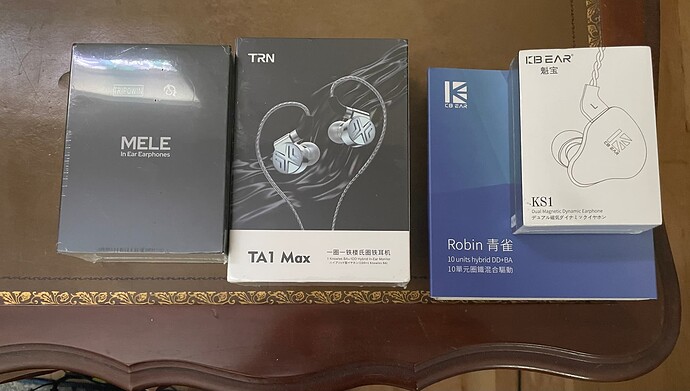TRN TA1 Max Review
Wanna hear what $50, a beryllium dynamic driver and a Knowles BA driver can get you? Well I think you should, and if you don’t I’m going to do my best to convince you, because this is my review of the TRN TA1 Max.
Songs to Listen to and Follow Along:
I’m going to write my thoughts in generalities, but I’ll give you a sample of songs that I listen to, that will relate to the concepts I write about. Feel free to ask for specifics, if you don’t keep up with my thought processes.
Vertigo - Alice Merton
I Can’t Give You Anything But Love - Red Garland
All Comes Crashing - Metric
Holdin’ On To Your Silence - Jozels
Going, Going, Gone - Wires and Lights
Spaghetti Stuck Against The Wall
So from different read-ups on the TA1 Max, this is the upgraded version of TRN’s original TA1, handing down the new 10mm DD from their more expensive BAX and incorporating a semi-open back design. I’ve seen it described as being “the BAX but taking out the EST drivers and making it $50.” I cannot judge the veracity of those claims, as I haven’t heard the BAX, but the impression I was getting is that there’s a lot of spaghetti thrown at the wall. My intention was to listen and come to my own conclusions as to whether this achieved the goal of a good sound for a very competitive price.
If You’re Lost In the Darkness, Look For the Light
There are two “first things” you can notice about the TA1 Max: 1). On one hand, the treble tuning is laid-back, to create what I would call a dark musical experience. This set is not tuned in a way that you are going to have to worry about sibilance. It is a completely smooth listen. 2). I kinda have to walk back that claim about this set actually being “laid-back” because the sound you get is pretty big. For such a small earphone (it’s really tiny, honestly), I don’t know how they produce such a big soundstage, and presence. Part of it has to do with the fact that the IEM is built with a semi open-back design. I think there must be more to it than just that, but the stage is wide, it’s deep, and allows for great expression when the tracks get busy. I didn’t know (or frankly think) you could get a soundstage like this for $50, and I am really impressed with it. But the soundstage you hear only matters if the sounds the speakers can make it matter.
Big Stage Deserves Big Sound
And these deliver! The TA1 Max was tuned to take that soundstage and fill it with big, boomy bass. There’s good sub-bass, which amplifies the really strong mid-bass. It lays the foundation of filling all the available space and it is engrossing, and very satisfying to listen to. The bass has its times of being too much and bleeding into the mids, no doubt about that. But it definitely has enough control that there isn’t a great loss of detail. You just have that feeling of thickness being present in songs. YMMV on whether that’s a positive or negative to you.
I Don’t Think You Know You’re Not Supposed To Be Here
The mids are a mixed bag of good and bad. They have good note-weight, due to the sheer amount of bass that comes before them, but to balance out the mids as best as possible the TA1 Max tries to thread a difficult needle. To keep the bloat down, without sacrificing note weight, the mids glide further than usual. Instead of tailing the bass off right at the mids, or going a few hundred hertz max into them, they travel deep into the lower-mids. To balance that out, the upper-mids have a short and steep climb up. This set is quite geared to male vocals, pushing them quite forward. Female vocals are a little less emphasized than other sets, though I wouldn’t call them recessed at all.
But First, There’s a Catch
And that catch is the treble. I’m not generally opposed to a cut after 6k. It’s not my most sensitive area, but it’s not a dealbreaker for me either. But wowsers, I KNOW this cut exists on the TA1 Max. It is just GONE. The deep treble has good extension but if treble really matters to you, and you’re not for that smooth-listening life, then this may very well be the dealbreaker for you. That said, I do not find the cut in the treble to be any kind of dealbreaker. It just keeps the energy before 6k and the treble extension beyond 10k under check. Somehow, even though what I’m describing shouldn’t work so well, it really does. And there’s a very good reason for this.
Two All-Beef Patties…
I wouldn’t walk away from this set too fast though, because there are two things this set has that you can’t judge in a tuning: the soundstage I mentioned before, and the technicalities of the driver set. This earphone works because the technicalities just will it to work. I cannot explain why the dynamic driver is snappy and boomy when needed, or how the BA takes over and keeps all that bass from overwhelming the entire signature. I don’t know why I don’t feel like all that missing treble isn’t the worst thing ever, or why it’s a worthy challenger to $80-100 (and beyond) sets. But I can tell you that all of these things are true. This is really a special set, for the under $100 crowd, and it should NOT be slept on.
But Why Aren’t You As Good As the 7Hz Zero?
Well, actually…the TA1 Max is as good as the 7Hz Zero. In fact, I would say if you’re not as big a fan of the neutral-bright tuning, this is quite better than the Zero. But that tuning is the thing holding this back. A few adjustments to the treble would have made this set so good, and probably both too good for the market to handle or for TRN’s other offerings to stay relevant. Because they absolutely could have sold this set for $80-100+ and been within their rights. The Zero stays with the TA1 Max in tuning, where the sheer domination in bass quantity and quality is what would move me to the TA1. The Zero simply doesn’t exist in the same class as the TA1 Max in soundstage and technicalities. The gap between the two is substantial.
Tri x HBB Kai - I would argue that the comparison of these two sets is similar to the previous comparison. If you want or need technicalities, I’d say grab the TA1 Max over the Kai in a heartbeat. It’s next level, and barely a fair fight. Where the Kai makes its argument for me is in tuning. It’s a superior tuned IEM, specifically because the treble is markedly better on the Kai. Working on a budget, where you were willing to get more than 1 set, but you valued long-duration and critical listening (because the two are different and require different things of your brain), then I wouldn’t hesitate to suggest getting both of these sets and calling it a day. They’re both fantastic at their intended use cases.
Tri Starsea (Standard setting) - This would be my moment of trying to figure out “Is there a musical upgrade, to justify the step up in price?” These two sets are my first experiences with hybrid setups, and part of me just wanted/needed to understand if this was just a honeymoon period with new technology, or if my hybrid experience was fundamentally different to listening to 1DD sets. The TA1 Max passed that test because it is just good at music reproduction. But it doesn’t do it better than Starsea. The Starsea has the note-weight with insignificant bass bleed. It’s more energetic in the upper mids, and it’s vastly superior in the treble. But TA1 Max absolutely has something special in its soundstage, and is the Starsea worth $130 when this exists? To me, yes. It’s just that bit more: In tuning, in technicalities, and even in staging. Starsea gives no ground to TA1 Max, so even though I’m highly impressed with it I never had a moment of “I regret buying Starsea because TA1 Max is so good.”
What’s It All Mean?
To me, it means the TA1 Max is a fantastic option on a budget, and anyone who buys it and listens to it has a chance to fall in love with something special. This is another shot at the idea that you have to spend a lot of money to get a great product. If you don’t have $200, $500, $1000 or even $100 to spend on audio gear, but don’t want to feel left behind in terms of sound quality, I can assure you there are options that are a huge bang for the buck. In the same vein as Zero at $20, and Olina at $100, previously unheard of value can also be found at $50. To that list, I submit the TRN TA1 Max.
Rank: B-
Rank With Personal Bias: B-
As a note: I’ve updated the top post with my google sheet, chronicling my IEM journey, and the rankings that come with them.
![]() ), and I’ve had so much fun hanging around these parts, and learned from you, that I kind of can’t help myself; I want to share my thoughts on the gear I listen to, and make another landing spot for people to enjoy conversing about music, and the gear we listen to it with. Especially since I’ve been getting my hands on more and more IEM sets (many that aren’t as hyped or of particular general interest) and I don’t want to clog up other threads with my thoughts. I’ll start to bring them here.
), and I’ve had so much fun hanging around these parts, and learned from you, that I kind of can’t help myself; I want to share my thoughts on the gear I listen to, and make another landing spot for people to enjoy conversing about music, and the gear we listen to it with. Especially since I’ve been getting my hands on more and more IEM sets (many that aren’t as hyped or of particular general interest) and I don’t want to clog up other threads with my thoughts. I’ll start to bring them here.

